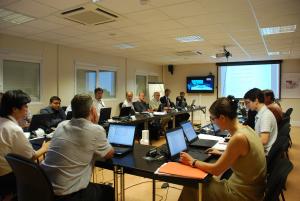Designing the world's largest high vacuum chamber
11 Jun 2010
-
Sabina Griffith
With the conclusion of the preliminary design review, the ITER cryostat passed another big milestone last week. Following the conceptual design review performed in November 2009, the review panel chaired by Felix Schauer from the Max Planck Institute (IPP) in Garching, Germany, once more went through all the design documents necessary for the Procurement Arrangement and looked at all the interfaces with other machine parts with special focus on in-vessel maintenance issues.
The ITER cryostat will be the world's largest high vacuum chamber. It is a single wall cylindrical vacuum vessel, with a vertical axis, a flat bottom and a tori-spherical top lid. Its internal diameter is about 28 metres, it's height is about 29 metres. It will hold a volume of about 8,500 m³.
Though it has to hold a high vacuum with a pressure of 1x10-4 Pa, the ITER cryostat will have about 200 penetrations in total. Most of them are small and provide the supply of power, water or helium for the in-cryostat components. Twenty-three of the penetrations are slightly larger in order to allow human access for maintenance reasons. The biggest "hole" in the cryostat (10 metres in diameter) is the top lid that can be taken off in case the central solenoid magnet needs to be exchanged.
"The main issue at the preliminary design review was to make sure that all the requirements concerning the design are fulfilled, but also that the enormous amount of interfaces to other components and the outside world are clearly defined," explains Felix Schauer. Naturally, it had also to be checked whether the manufacturing of the components, assembly and later maintenance of the cryostat can be done in a robust way with reasonable effort, and in conformance with all the requirements.
"Even though I come from a large and certainly complex fusion project—the stellarator Wendelstein 7-X in Greifswald, Germany—it was quite impressive when I got in such close contact to the huge ITER cryostat," Schauer comments. "However, the particular challenge for the ITER design as compared to other fusion experiments is not just its size but the fact that it is a nuclear machine and thus everything from design to operation and later decommissioning has to obey corresponding rigorous nuclear regulations."
Since this was a preliminary design review, it is evident that not all detailed questions can be solved at this point. Open issues were lively discussed, and corresponding "chits," i.e., written questions, comments and recommendations, were raised by the members of the meeting. At the end, the review panel came to the conclusion that the cryostat has a sound design and can be built and assembled as it is envisaged. Open issues like completion of some design documents, detailing of interface specifications or special calculations will not significantly influence the design and will be settled before the final design review. Due to the committed and active cooperation of the meeting members, this preliminary design review was a very fruitful event in a pleasant atmosphere.


